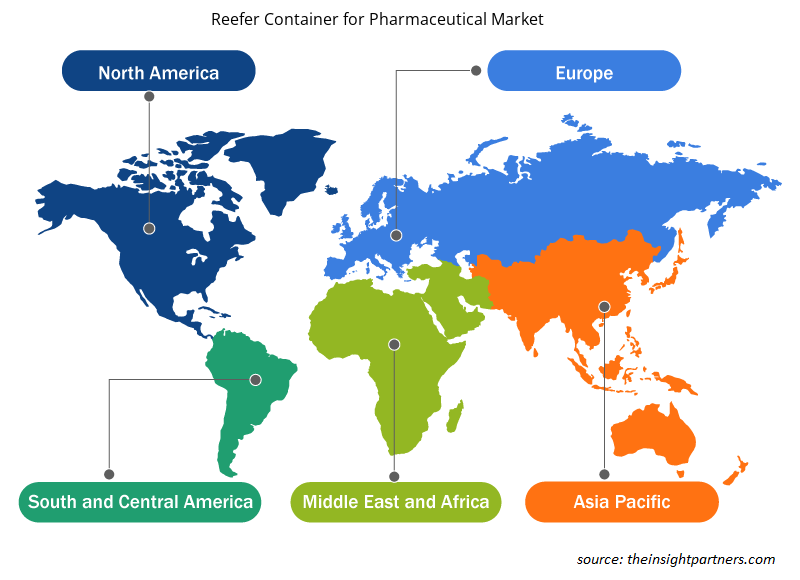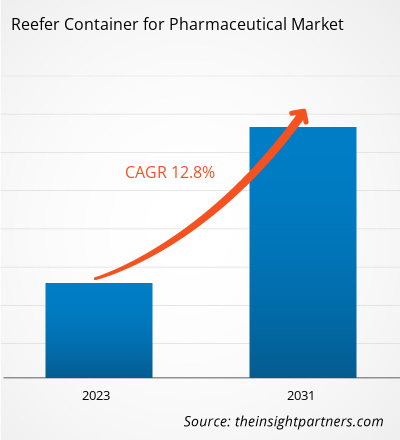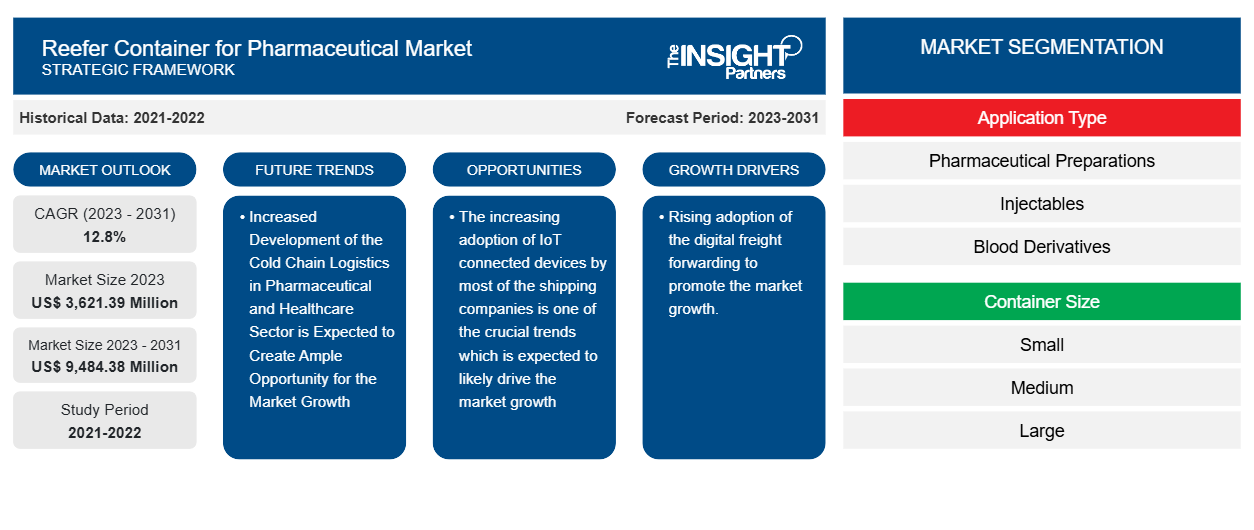Das Marktvolumen für Kühlcontainer für Pharmazeutika soll von 3.621,39 Millionen US-Dollar im Jahr 2023 auf 9.484,38 Millionen US-Dollar im Jahr 2031 anwachsen. Der Markt wird zwischen 2023 und 2031 voraussichtlich eine durchschnittliche jährliche Wachstumsrate (CAGR) von 12,8 % verzeichnen. Die zunehmende Nutzung von IoT-verbundenen Geräten durch die meisten Reedereien ist einer der entscheidenden Trends, der das Marktwachstum voraussichtlich vorantreiben wird.
Kühlcontainer für die Pharmamarktanalyse
Die Ökosystemanalyse für den globalen Kühlcontainermarkt für Pharmazeutika umfasst Depot, Binnenfrachtführer, Seetransport, Spedition, Vertriebszentrum und Kühlcontainer-Dienstleister oder -Hersteller. Das Containerdepot übernimmt alle notwendigen Dienstleistungen rund um leere Container, sei es Reparaturen, Reinigung, Inspektion oder Lagerung. Das Depot bewahrt auch die pharmazeutischen Produkte für die regelmäßige Inspektion und Wartung der Kühlcontainer auf, was für alle Beteiligten im Lieferkettenprozess der Kühllagerung von entscheidender Bedeutung ist. Die Binnenfrachtführer arbeiten mit anderen Logistikparteien wie Verladern, Binnenhäfen, Terminalbetreibern und Straßentransporteuren zusammen, um ein integrierter Bestandteil der Kette zu werden. Diese Kette muss so organisiert sein, dass die Stärken der Binnenschifffahrt optimal genutzt werden, wie z. B. große Containermengen, keine Stauprobleme und geringe Kohlenstoffemissionen.
Kühlcontainer für Pharmazeutika – Marktübersicht
Der Kühlcontainer ist ein Kühlcontainer, der im intermodalen Güterverkehr in der Pharmaindustrie verwendet wird. Er wird am häufigsten für den Transport von Medikamenten, zu analysierenden biologischen Proben, Impfstoffen, Blut und Derivaten verwendet. Der Anstieg des internationalen Handels und die einfachen Navigationsmöglichkeiten, kürzere Terminalumlaufzeiten und Wachstumsaussichten im Überseehandel sind einige wichtige Faktoren, die der Nachfrage nach Kühlcontainern in der Pharmaindustrie zugeschrieben werden und das Marktwachstum vorantreiben. Die technologische Entwicklung für Kühlcontainer verstärkt die Nachfrage nach Kühlkettenanwendungen weiter. Die pharmazeutischen Kühleinheiten können die Temperatur pharmazeutischer Produkte regeln und ermöglichen es dem Versender, sie während der gesamten Reise zu überwachen. Diese Container sind außerdem mit sensorbasierter Technologie ausgestattet, die kleine Temperaturschwankungen erkennen und sogar feststellen kann, ob die Produkte Licht ausgesetzt sind, was bei bestimmten Arzneimitteln zu Verunreinigungen führen könnte. Die hochwertigen Kühlcontainer, die im Allgemeinen mit hochmodernen Geräten zur Überwachung von Temperaturschwankungen ausgestattet sind, sind ideal, um optimale Bedingungen für den Versand von Produkten aufrechtzuerhalten, die verderben könnten, und sie trotz äußerer Bedrohungen unbeschädigt zu halten, bis sie ihr endgültiges Ziel erreichen. Behälter mit derartigen Merkmalen sowie integrierten Sensoren und Überwachungsgeräten erhöhen den Bedarf an effizienten Kühlbehältern in der Pharmaindustrie und treiben das Marktwachstum voran.
Passen Sie diesen Bericht Ihren Anforderungen an
Sie erhalten kostenlose Anpassungen an jedem Bericht, einschließlich Teilen dieses Berichts oder einer Analyse auf Länderebene, eines Excel-Datenpakets sowie tolle Angebote und Rabatte für Start-ups und Universitäten.
-
Holen Sie sich die wichtigsten Markttrends aus diesem Bericht.Dieses KOSTENLOSE Beispiel umfasst eine Datenanalyse von Markttrends bis hin zu Schätzungen und Prognosen.
Kühlcontainer für Pharmazeutika – Treiber und Chancen
Steigende Nutzung der digitalen Spedition fördert das Marktwachstum
Die digitale Speditionsplattform überwacht und verwaltet ihre Sendungen kontinuierlich in Echtzeit, was den Versendern Transparenz bietet. Der Einsatz fortschrittlicher Technologie beim Transport von Kühlcontainern trägt somit dazu bei, den Transport von Kühlcontainern zuverlässiger und effizienter zu gestalten. Der Kühlcontainer wird zu einem nahegelegenen Seehafen transportiert, um auf einem Containerschiff in seine Zielregion verschifft zu werden. Im Zielhafen wird er entladen und zu einem Vertriebszentrum transportiert. Hier wird die Ladung aus dem Container ausgepackt und in kleineren Paketen weiter an Einzelhändler verteilt. Im Vertriebszentrum wird der Container ausgepackt und die Ladung weiter verteilt und verarbeitet.
Die verstärkte Entwicklung der Kühlkettenlogistik im Pharma- und Gesundheitssektor dürfte reichlich Möglichkeiten für Marktwachstum schaffen
Der Einsatz fortschrittlicher Technologien in der Lieferkette der Pharmaindustrie rückt immer stärker in den Fokus und es werden neue Wege gefunden, um sicherzustellen, dass medizinische Produkte sicher an ihren Bestimmungsort geliefert werden. Die Entwicklung von Kühlketten für die Pharmaindustrie konzentriert sich auf Kontrollturmtechnologie, Verpackungsautomatisierung , künstliche Intelligenz und andere Technologien. In den letzten Jahren haben kontinuierliche Fortschritte bei der Entwicklung und Verbreitung temperaturempfindlicher pharmazeutischer Produkte – von biologischen Therapien zur Behandlung seltener und chronischer Krankheiten, dem COVID-19-Impfstoff und Impfstoffen gegen andere Infektionskrankheiten, neuartigen onkologischen Behandlungen bis hin zu Zell- und Gentherapien (CGT) – zu komplexeren Anforderungen an die Kühlkette geführt als je zuvor. Laut jüngsten Schätzungen wird Indiens Kühllagerkapazität im August 2022 bis 2023 voraussichtlich 40,7 Millionen Tonnen erreichen und damit 8,2 % gegenüber 2020 steigen, was potenzielle Chancen für indische Kühlkettenanlagen schafft, die das Marktwachstum vorantreiben. Außerdem wird laut öffentlichen Statistiken erwartet, dass der Kühlkettensektor bis 2025 um mehr als 20 % durchschnittlich jährlich wächst, was auf die Umstellung von konventioneller Kühllagerung auf moderne Lagerräume zurückzuführen ist. Im August 2022 kündigte die AP Maersk Company die Planung eines neuen Kühllagers in Ridgeville, South Carolina, an, in dem temperaturgeregelte Waren gelagert werden sollen. Das neue Lager soll voraussichtlich im ersten Quartal 2023 in Betrieb gehen.
Kühlcontainer für Pharmazeutika Marktbericht Segmentierungsanalyse
Wichtige Segmente, die zur Ableitung der Marktanalyse für Kühlcontainer für Pharmazeutika beigetragen haben, sind Anwendungstyp, Containergröße und Geografie.
- Basierend auf der Anwendungsart ist der Markt in pharmazeutische Präparate, Injektionspräparate, Blutderivate, Impfstoffe und Serum und andere unterteilt. Unter diesen dürften pharmazeutische Präparate im Jahr 2023 den größten Anteil haben, da die Arzneimittelproduktion und die Nachfrage nach fortschrittlichen Medikamenten für chronische Krankheiten steigen.
- Je nach Behältergröße wird der Markt in kleine, mittlere und große Behälter unterteilt. Kleine Behältergrößen hatten im Jahr 2023 den größten Anteil. Dies ist auf das exponentielle Wachstum pharmazeutischer Produkte in Entwicklungsländern wie Indien, Mexiko, Brasilien und Argentinien zurückzuführen.
Kühlcontainer für Pharmazeutika Marktanteilsanalyse nach Geografie
Der geografische Umfang des Marktberichts über Kühlcontainer für Pharmazeutika ist hauptsächlich in fünf Regionen unterteilt: Nordamerika, Asien-Pazifik, Europa, Naher Osten und Afrika sowie Südamerika.
Der asiatisch-pazifische Raum gilt als die am schnellsten wachsende Wirtschaftsregion, wobei China und Indien die am schnellsten wachsenden Volkswirtschaften der Welt sind. Die Regulierungsbehörde der maritimen Industrie in den Ländern des asiatisch-pazifischen Raums konzentriert sich stark auf die Verbesserung der Handelsaktivitäten, die die Nachfrage nach Kühlcontainern beeinflussen. So hat China im Januar 2022 konventionelle Zollsätze auf Produkte aus 29 Ländern angewendet. China hat 19 bilaterale oder multilaterale Freihandelsabkommen mit mehr als 29 Ländern oder Regionen unterzeichnet. Solche Faktoren beschleunigen also die Nachfrage nach Kühlcontainern und das Marktwachstum in dieser Region.
Regionale Einblicke in den Kühlcontainer für den Pharmamarkt
Die regionalen Trends und Faktoren, die den Markt für Kühlcontainer für Pharmazeutika im Prognosezeitraum beeinflussen, wurden von den Analysten von Insight Partners ausführlich erläutert. In diesem Abschnitt werden auch die Marktsegmente und die Geografie von Kühlcontainern für Pharmazeutika in Nordamerika, Europa, im asiatisch-pazifischen Raum, im Nahen Osten und Afrika sowie in Süd- und Mittelamerika erörtert.

- Erhalten Sie regionalspezifische Daten zum Kühlcontainermarkt für Pharmazeutika
Umfang des Marktberichts über Kühlcontainer für Pharmazeutika
| Berichtsattribut | Details |
|---|---|
| Marktgröße im Jahr 2023 | 3.621,39 Millionen US-Dollar |
| Marktgröße bis 2031 | 9.484,38 Millionen US-Dollar |
| Globale CAGR (2023 - 2031) | 12,8 % |
| Historische Daten | 2021-2022 |
| Prognosezeitraum | 2023–2031 |
| Abgedeckte Segmente |
Nach Anwendungstyp
|
| Abgedeckte Regionen und Länder |
Nordamerika
|
| Marktführer und wichtige Unternehmensprofile |
|
Dichte der Kühlcontainer für Pharmaunternehmen: Auswirkungen auf die Geschäftsdynamik verstehen
Der Markt für Kühlcontainer für Pharmazeutika wächst rasant, angetrieben durch die steigende Nachfrage der Endverbraucher aufgrund von Faktoren wie sich entwickelnden Verbraucherpräferenzen, technologischen Fortschritten und einem größeren Bewusstsein für die Vorteile des Produkts. Mit steigender Nachfrage erweitern Unternehmen ihr Angebot, entwickeln Innovationen, um die Bedürfnisse der Verbraucher zu erfüllen, und nutzen neue Trends, was das Marktwachstum weiter ankurbelt.
Die Marktteilnehmerdichte bezieht sich auf die Verteilung von Firmen oder Unternehmen, die in einem bestimmten Markt oder einer bestimmten Branche tätig sind. Sie gibt an, wie viele Wettbewerber (Marktteilnehmer) in einem bestimmten Marktraum im Verhältnis zu seiner Größe oder seinem gesamten Marktwert präsent sind.
Die wichtigsten Unternehmen auf dem Markt für Kühlcontainer für Pharmazeutika sind:
- Maersk Container Industry AS
- Evergreen Marine Corp. (Taiwan) Ltd
- BSL KÜHLCONTAINER
- CMA CGM-Gruppe
- und Klinge Corporation und unter anderem
Haftungsausschluss : Die oben aufgeführten Unternehmen sind nicht in einer bestimmten Reihenfolge aufgeführt.

- Überblick über die wichtigsten Akteure auf dem Markt für Kühlcontainer für Pharmazeutika
Reefer to Container für Pharmamarktnachrichten und aktuelle Entwicklungen
Der Kühlcontainer für den Pharmamarkt wird durch die Erfassung qualitativer und quantitativer Daten nach Primär- und Sekundärforschung bewertet, die wichtige Unternehmensveröffentlichungen, Verbandsdaten und Datenbanken umfasst. Nachfolgend sind einige der Entwicklungen im Kühlcontainer für den Pharmamarkt aufgeführt:
- Ocean Network Express (ONE) freut sich, in Zusammenarbeit mit Pan Pacific International Holdings Inc. (PPIH) und NAX Japan den Start des weltweit ersten Versuchs eines Kühlcontainers mit Zweitemperaturfunktion und Controlled Atmosphere (CA)-Funktion bekannt zu geben. Es handelt sich um den weltweit ersten Einsatz eines Kühlcontainers mit Zweitemperaturfunktion auf dem Seeweg. (Quelle: Nachrichten auf der Website des Unternehmens, Februar 2024)
- CMA CGM bringt SMART Reefer Container auf den Markt, einen vernetzten Container für Kühlgüter. Mit SMART Reefer Container* können Sie die Position und den Status Ihrer Kühlgüter verfolgen und sicherstellen, dass sie unter optimalen Bedingungen transportiert werden. Das Supply Chain Management wird durch eine intuitive Online-Schnittstelle erleichtert, die in Echtzeit aktualisiert wird. So können Sie bei jedem Schritt des Transportprozesses proaktiver vorgehen. (Quelle: Unternehmenswebsite-News, Mai 2024)
Marktbericht zu Kühlcontainern für Pharmazeutika – Abdeckung und Ergebnisse
Der Bericht „Marktgröße und Prognose für Kühlcontainer für Pharmazeutika (2021–2031)“ bietet eine detaillierte Analyse des Marktes, die die folgenden Bereiche abdeckt:
- Kühlcontainer für die Pharmamarktgröße und -prognose auf globaler, regionaler und Länderebene für alle wichtigen Marktsegmente, die im Rahmen des Berichts abgedeckt sind
- Kühlcontainer für Pharmamarkttrends sowie Marktdynamik wie Treiber, Einschränkungen und wichtige Chancen.
- Detaillierte PEST- und SWOT-Analyse
- Marktanalyse für Kühlcontainer für Pharmazeutika mit wichtigen Markttrends, globalen und regionalen Rahmenbedingungen, wichtigen Akteuren, Vorschriften und aktuellen Marktentwicklungen
- Branchenlandschaft und Wettbewerbsanalyse, einschließlich Marktkonzentration, Heatmap-Analyse, prominenten Akteuren und aktuellen Entwicklungen für Kühlcontainer für den Pharmamarkt
- Detaillierte Firmenprofile
- Historische Analyse (2 Jahre), Basisjahr, Prognose (7 Jahre) mit CAGR
- PEST- und SWOT-Analyse
- Marktgröße Wert/Volumen – Global, Regional, Land
- Branchen- und Wettbewerbslandschaft
- Excel-Datensatz
Aktuelle Berichte
Verwandte Berichte
Erfahrungsberichte
Grund zum Kauf
- Fundierte Entscheidungsfindung
- Marktdynamik verstehen
- Wettbewerbsanalyse
- Kundeneinblicke
- Marktprognosen
- Risikominimierung
- Strategische Planung
- Investitionsbegründung
- Identifizierung neuer Märkte
- Verbesserung von Marketingstrategien
- Steigerung der Betriebseffizienz
- Anpassung an regulatorische Trends























 Kostenlose Probe anfordern für - Kühlcontainer für den Pharmamarkt
Kostenlose Probe anfordern für - Kühlcontainer für den Pharmamarkt